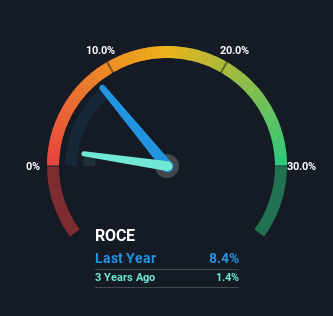- India
- /
- Healthcare Services
- /
- NSEI:SHALBY
We Like These Underlying Return On Capital Trends At Shalby (NSE:SHALBY)

If you're not sure where to start when looking for the next multi-bagger, there are a few key trends you should keep an eye out for. Firstly, we'd want to identify a growing return on capital employed (ROCE) and then alongside that, an ever-increasing base of capital employed. This shows us that it's a compounding machine, able to continually reinvest its earnings back into the business and generate higher returns. With that in mind, we've noticed some promising trends at Shalby (NSE:SHALBY) so let's look a bit deeper.
What Is Return On Capital Employed (ROCE)?
Just to clarify if you're unsure, ROCE is a metric for evaluating how much pre-tax income (in percentage terms) a company earns on the capital invested in its business. Analysts use this formula to calculate it for Shalby:
Return on Capital Employed = Earnings Before Interest and Tax (EBIT) ÷ (Total Assets - Current Liabilities)
0.084 = ₹914m ÷ (₹13b - ₹1.9b) (Based on the trailing twelve months to June 2023).
So, Shalby has an ROCE of 8.4%. Ultimately, that's a low return and it under-performs the Healthcare industry average of 14%.
View our latest analysis for Shalby

Above you can see how the current ROCE for Shalby compares to its prior returns on capital, but there's only so much you can tell from the past. If you'd like, you can check out the forecasts from the analysts covering Shalby here for free.
So How Is Shalby's ROCE Trending?
While in absolute terms it isn't a high ROCE, it's promising to see that it has been moving in the right direction. The data shows that returns on capital have increased substantially over the last five years to 8.4%. Basically the business is earning more per dollar of capital invested and in addition to that, 28% more capital is being employed now too. So we're very much inspired by what we're seeing at Shalby thanks to its ability to profitably reinvest capital.
What We Can Learn From Shalby's ROCE
In summary, it's great to see that Shalby can compound returns by consistently reinvesting capital at increasing rates of return, because these are some of the key ingredients of those highly sought after multi-baggers. And with a respectable 57% awarded to those who held the stock over the last five years, you could argue that these developments are starting to get the attention they deserve. With that being said, we still think the promising fundamentals mean the company deserves some further due diligence.
One more thing to note, we've identified 1 warning sign with Shalby and understanding it should be part of your investment process.
While Shalby may not currently earn the highest returns, we've compiled a list of companies that currently earn more than 25% return on equity. Check out this free list here.
If you're looking to trade Shalby, open an account with the lowest-cost platform trusted by professionals, Interactive Brokers.
With clients in over 200 countries and territories, and access to 160 markets, IBKR lets you trade stocks, options, futures, forex, bonds and funds from a single integrated account.
Enjoy no hidden fees, no account minimums, and FX conversion rates as low as 0.03%, far better than what most brokers offer.
Sponsored ContentNew: Manage All Your Stock Portfolios in One Place
We've created the ultimate portfolio companion for stock investors, and it's free.
• Connect an unlimited number of Portfolios and see your total in one currency
• Be alerted to new Warning Signs or Risks via email or mobile
• Track the Fair Value of your stocks
Have feedback on this article? Concerned about the content? Get in touch with us directly. Alternatively, email editorial-team (at) simplywallst.com.
This article by Simply Wall St is general in nature. We provide commentary based on historical data and analyst forecasts only using an unbiased methodology and our articles are not intended to be financial advice. It does not constitute a recommendation to buy or sell any stock, and does not take account of your objectives, or your financial situation. We aim to bring you long-term focused analysis driven by fundamental data. Note that our analysis may not factor in the latest price-sensitive company announcements or qualitative material. Simply Wall St has no position in any stocks mentioned.
About NSEI:SHALBY
Shalby
Engages in the operation of multi-specialty hospitals primarily in India, the United States, Japan, Indonesia, Oman, the United Arab Emirates, Bangladesh, Nepal, and internationally.
Reasonable growth potential with adequate balance sheet.
Market Insights
Community Narratives




